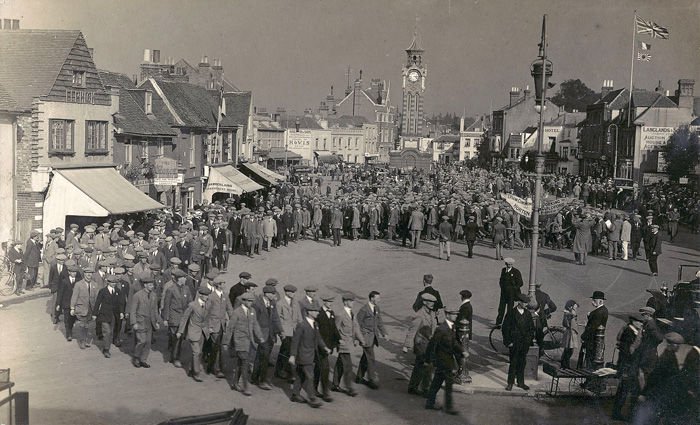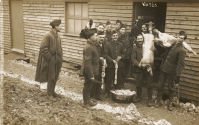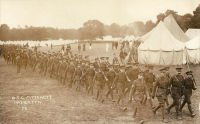 On 4 August 1914, Britain was at war. By the next day, Field Marshal Earl Kitchener of Khartoum had been appointed Minister for War and immediately issued orders for the expansion of the army. He did not believe that the war would be 'over by Christmas' and had a plan to expand the regular army by raising a new component composed of wartime volunteers. Each man would sign up for new "general service" terms of three years or the duration of the war (whichever the longer) and would agree to being sent to serve anywhere the army needed them.
On 4 August 1914, Britain was at war. By the next day, Field Marshal Earl Kitchener of Khartoum had been appointed Minister for War and immediately issued orders for the expansion of the army. He did not believe that the war would be 'over by Christmas' and had a plan to expand the regular army by raising a new component composed of wartime volunteers. Each man would sign up for new "general service" terms of three years or the duration of the war (whichever the longer) and would agree to being sent to serve anywhere the army needed them.
On 6 August, Parliament sanctioned an increase of 500,000 men of all ranks and, on 11 August, 'Your King and Country need you: a call to arms' was published. It explained the new terms of service and called for the first 100,000 men to enlist. This figure was achieved within two weeks. Known as K1, this was the beginning of Kitchener's Army. As news came from the Front that British regulars were in action and in retreat, the levels of recruitment increased; by 10 December 1914 over 400,000 men had volunteered but it was not until May 1915 that the earliest recruits were ready to be sent overseas. First they had to be kitted out, trained and turned into soldiers.
 The new recruit was first sent to his Regimental depot, where he received his kit and was introduced to army discipline and training. Next, he was sent to a training camp to join his battalion. However in practice, none of the regiments had the required stocks of equipment or the manpower to train the flood of recruits, so at first men trained wearing their own clothes and shoes. This led to some bizarre situations where recruits might be issued old stored uniforms, including vintage red jackets. Others bought their own uniform and boots with money paid from public collections. Many regiments were issued with emergency blue uniforms, popularly known as Kitchener Blue.
The new recruit was first sent to his Regimental depot, where he received his kit and was introduced to army discipline and training. Next, he was sent to a training camp to join his battalion. However in practice, none of the regiments had the required stocks of equipment or the manpower to train the flood of recruits, so at first men trained wearing their own clothes and shoes. This led to some bizarre situations where recruits might be issued old stored uniforms, including vintage red jackets. Others bought their own uniform and boots with money paid from public collections. Many regiments were issued with emergency blue uniforms, popularly known as Kitchener Blue.
There was also a lack of officers to train the recruits. The government called up all reserve-list officers, and many British Indian Army officers on leave in the UK were also quickly re-assigned. Men who had been to a public school, who had some military training in Officer Training Corps, were often granted direct commissions.
The Army also had difficulty supplying new units with enough weapons. No artillery pieces had been left in Britain to train new artillery brigades, and most battalions had to drill with obsolete rifles or wooden mock-ups but by early 1915 many of these problems had been overcome.
 Life in the camps for many of the new recruits, although chaotic and initially rather a shambles, must have been a heady mixture of enthusiasm, patriotism and, for those who had joined up with friends in local units often referred to as Pals, bonhomie. The majority were young and away from home for the first time, but fired with the desire to fight for and defend their country. The realities of the cold, uncomfortable and disciplined life in barracks were probably shrugged off by the communal sense of 'doing their duty'.
Life in the camps for many of the new recruits, although chaotic and initially rather a shambles, must have been a heady mixture of enthusiasm, patriotism and, for those who had joined up with friends in local units often referred to as Pals, bonhomie. The majority were young and away from home for the first time, but fired with the desire to fight for and defend their country. The realities of the cold, uncomfortable and disciplined life in barracks were probably shrugged off by the communal sense of 'doing their duty'.
These postcards, so different from the later images from the trenches of Flanders, capture this sense of life in the camps. There is a laughter in these soldiers eyes and a sense of comradeship and excitement, not yet overshadowed by what was to come.
Images
- Epsom, recruiting parade for the Royal Fusiliers, High Street, circa 1914 (reference PC/58/82)
- Woldingham camp - view of soldiers outside a meat store with a bucket of sausages and pig carcasses, circa 1915 (reference PC/161/12)
- Frimley, Officer Training Corps Camp at Mytchett, No. 3 Battalion marching, circa 1915 (reference PC/68/28)

